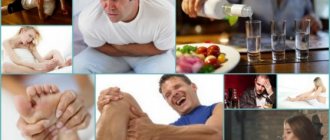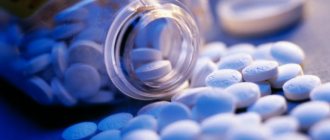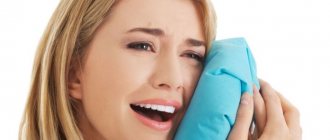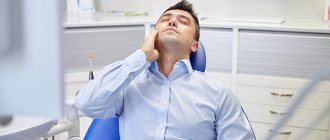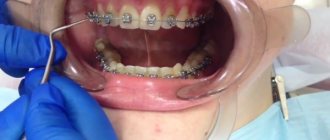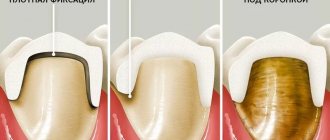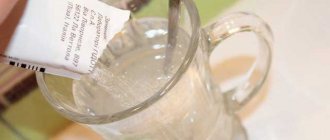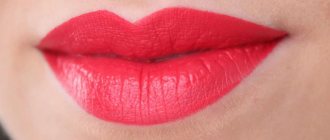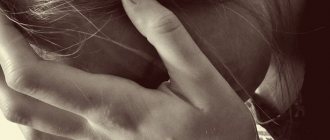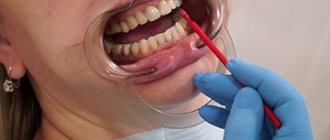Fundamental Principles
If a child has a toothache, before eliminating the toothache, you need to become familiar with the main principles of treatment:
- performing early pharmacotherapy and determining the cause;
- getting rid of the pathogenetic factor;
- Based on the child’s condition, the effectiveness of pain relief is assessed;
- Based on the intensity of the syndrome, the choice of anesthetic drug is made.
The main amount of pain during tissue damage appears during the production of cytokines and prostaglandins, which activate inflammatory processes.
The main direction in the action of drugs against toothache is the reduction of prescription sensitivity and the release of pain mediators.
Massaging technique: how to properly influence the points
Each point needs to be massaged in a special way. This way, getting rid of acute toothache will be as effective as possible.
- The He-gu point must be pressed with the thumb of the opposite hand. The duration of the procedure is from 2 to 3 minutes, until the skin turns red.
- In the area where the jaws close, the massage should be gentle so as not to damage the masticatory muscles. First, apply light pressure with your index finger, then make circular movements 30 times. Repeat until the toothache subsides, but no more than 5 approaches.
- To massage the point on the index finger, lightly press with your fingers 1 mm from the nail. The manipulation is continued until painful sensations occur.
- The area between the ring and middle fingers is applied with the tip of the nail. An unpleasant tingling sensation should appear.
- The wrist can be massaged for up to half an hour. Apply the thumb of the opposite hand and apply soft circular movements. You can also attach a piece of garlic or horseradish to the area.
The wrist can be massaged for up to half an hour.
Important! Do not be afraid that the location of the point is not determined accurately. The massage affects a wide area, so a deviation of a few millimeters will not play a significant role.
Ibuklin junior
A medicine based on ibuprofen and paracetamol. Eliminates even severe toothache in the shortest possible time. Recommended for children aged 3 to 12 years.
The tablets are taken orally, dissolved in 5 ml of liquid. Children 3-6 years old (body weight 13-20 kg) are allowed to drink 3 tablets per day; 6-12 years (weighing 20-40 kg) - 6 tablets.
Incorrect dosage and exceeding the permissible limit can cause adverse reactions:
- nausea, loss of appetite, vomiting;
- headache and sleep disturbances;
- dysfunction of hematopoiesis;
- renal dysfunction;
- skin rash.
If vision deteriorates during treatment with Ibuklin, you must stop taking the drug and consult an ophthalmologist.
How to relieve toothache in children of different ages
First aid for dental problems is to relieve pain. It is impossible to cure bad teeth at home, but it is quite possible to relieve a child’s suffering before going to the dentist.
What can you give your child for toothache:
- Acute manifestations are suppressed by analgesics - tablets, suppositories, syrups. When using them, be sure to familiarize yourself with age-related contraindications.
- Dental gel relieves gum pain in infants and older children.
- Non-traditional methods, for example, acupressure, the use of which is allowed at any age, have a calming effect.
- For children four years of age and older, traditional methods of pain relief are suitable. It is better not to experiment with younger children, as they may have an allergic reaction.
How to do massage at home
Acupressure can be done independently at home. To do this, it is better to choose a quiet place so that you can concentrate. Follow this order:
- Sit in a comfortable position (sitting, lying down). Breathe deeply and try to relax your muscles and limbs.
- Press on the desired area, applying fairly strong pressure, but without fanaticism. If you feel sharp pain, reduce the pressure until you feel a balance of pain and pleasure. Do not rub or massage the area, but maintain constant pressure.
Tip: The middle finger is best for acupressure, as it is longer and stronger than the others. The thumb also works.
- After holding the point for the desired amount of time, slowly release it. It is the gradual removal that gives the tissues time to react to the release of pressure.
- Repeat the massage as many times as you want; there is no limit on the number of times per day.
Remember that acupressure is not an immediate solution to the problem. You need to be patient and consistent. It may happen that the pain will subside and then return again. In such a situation, the procedure should be repeated.
Ketanov and ketorol
Preparations based on ketorolac. They have a strong and quick pain-relieving effect. Due to its aggressive effects on the body, Ketanov is not recommended for children under 16 years of age. Using the drug at an early age can provoke:
- severe nausea and vomiting;
- allergic rashes;
- bleeding of the gastrointestinal tract;
- headaches and disturbances of consciousness;
- peptic ulcers of the digestive system.
It is preferable to use other drugs in the treatment of childhood toothache.
Painkillers for toothache in children
Different medications are suitable for children of different ages. If a child under 5 years old has a toothache, it is better to anesthetize it with gels and ointments. To relieve symptoms in older children, you can use tablets, syrups, suppositories and drops.
Effective drugs:
- Paracetamol for children - allowed from three months. Analogues - Panadol, Tsefekon, Efferalgan.
- Ibuprofen is allowed from three months. Analog – Nurofen.
- Nimesulide - allowed from the age of three. Analogues - Nise, Nimesil.
To choose a safe pain reliever for toothache in a child, it is important to pay attention to age restrictions and contraindications. When using the drug, the dosage must be strictly observed.
Gels for topical use can remove mild discomfort in the gums and teeth, act almost instantly, are allowed from a very early age, and have analgesic, antibacterial and anti-inflammatory properties. They show themselves effectively:
- Cholisal-gel.
- Kalgel.
- Kamistad.
- Dentinox.
You should not abuse medications, no matter how safe they may seem. It is important to fight not the symptom - toothache, but the cause of its occurrence.
If a child has a baby toothache and the parents do not want to give him medications, they can resort to homeopathy. The following will help remove painful sensations:
- Ointment Traumgel-C. The herbal components of the product relieve pain, swelling, and inflammation.
- Dentinorm Baby drops. In addition to anesthetizing teeth, they bring relief from diseases of the nasopharynx.
- Viburkol suppositories. Herbal children's remedy with antispasmodic, anti-inflammatory, analgesic properties.
We invite you to familiarize yourself with the stages of treatment of deep caries
Contraindications for use
Massage may not always bring only benefits. There are categories of people for whom it is strictly contraindicated.
You should also not do it on an empty stomach or after coffee. If you have a toothache, it is not recommended to drink stimulating drinks, which affect the already tense nervous system. It is best to drink relaxing green tea, which contains a lot of fluoride that is beneficial for teeth, or still mineral water. Drinking alcoholic drinks is also extremely undesirable.
Anti-inflammatory drugs
If toothache is accompanied by elevated body temperature, this is a sign of the development of an inflammatory process. Anti-inflammatory drugs have a systemic effect, allowing for a long-term effect (up to 12 hours). They not only help cope with inflammation, but also normalize temperature, relieve pain and improve overall well-being:
- Nurofen for children. A strong anesthetic in the form of a suspension. Can be given to babies from 3 months of age. Patients aged 12 years and older are allowed to take the drug for adults (in tablets) in accordance with the instructions.
- Acetylsalicylic acid and drugs based on it (for example, Acetlysin or Asphen). They relieve pain well, are effective in inflammatory processes, but are contraindicated in children under 1 year of age (the restriction is strict; aspirin-based medications are strictly forbidden to be given to infants even at 9-11 months of age).
- Nimesulide and other drugs of the non-steroidal selective group. The action of the drugs is based on the fact that the active components selectively block the synthesis of prostaglandin. Do not take if you have kidney failure or liver disease.
The most effective tablets for toothache
Which pill to take for a toothache, when there are so many drugs on the market, is a pressing question. Analgesics have different origins. There are opioid (narcotic) drugs, as well as steroid (hormone-based) and non-steroidal analgesics.
In dentistry, nonsteroidal anti-inflammatory drugs (NSAIDs) are used to combat toothache. The effectiveness of tablets is determined by the speed of action, the quality and duration of the analgesic effect, as well as safety for the body.
Based on these indicators, the best tablets for toothache are selected.
If the pain is acute
The most effective points for toothache on the hand are the nail phalanges on the two middle fingers. You should press them hard and intensely. For convenience, you can count to 20, then take a break for five seconds and continue pressing again. It is believed that the inner phalanges of the fingers are responsible for the soft tissues of the teeth. You can use the following method: instead of a finger, use a match, which is pressed pointwise in the middle of the phalanx from the inside. You can massage your feet at the same time.
Strong tablets for toothache without prescriptions
Over-the-counter toothache tablets usually have fewer contraindications than stronger drugs and have less impact on the body.
This applies to problems with the respiratory and cardiovascular systems, liver, kidneys and stomach, which inevitably arise with an overdose of the most powerful analgesics. Despite the fact that a prescription is not required for their use, the best of the drugs presented work well even with severe toothache.
On the other hand, with serious complications of pulpitis and periodontitis, when the pain can truly be unbearable, prescription drugs may be more effective.
| Drug name | Description |
| Nurofen | Perhaps the most popular drug for temporary relief from toothache, the main active ingredient of which is ibuprofen. Effective for long-term moderate toothaches (on average lasts up to 7 hours). Has an anti-inflammatory effect. With proper dosing, the likelihood of complications is minimal. Nurofen can be taken by children from 6 years of age and during pregnancy (however, not in all trimesters). Side effects: nausea, stomach cramps, dizziness. It is not recommended to take in case of renal and liver failure. |
| Tempalgin | Another popular analgesic of combined action. In addition to pain relief, it has antipyretic and anti-inflammatory effects. Copes well with mild to moderate toothache due to caries and pulpitis. The maximum daily dose of tablets is 6 pieces. It is not recommended to use the drug for more than 5 days. Contraindicated in children under 12 years of age and in some trimesters of pregnancy. |
| Paracetamol and drugs based on it | The most popular and inexpensive analgesic with antipyretic properties. Particularly effective for moderate toothaches. Compared to most analgesics, it has a minimal number of contraindications and can be used during pregnancy (conditionally) and in childhood. Another paracetamol-based drug, Dolospa, is also actively used. This is a more powerful and fast-acting analgesic, which, on the other hand, has more contraindications. |
Note: other ibuprofen-based drugs may be an alternative to Nurofen. The most famous analogue of Nurofen is Mig tablets for toothache, which are produced in Germany.
Biological points that help eliminate toothache
Below are the 6 most common points, the stimulation of which helps to get rid of toothache. You don't need to stimulate them all every time, just try it once and see which ones work best for you.
SI 18
It is one of the most important acupressure and acupuncture points for toothache relief and is often used as first aid. SI 18 is located at the lower edge of the cheekbone in line with the outer corner of the eye, opposite the lower edge of the nose.
This point can be activated by applying steady pressure for 1 minute. You need to press simultaneously on both sides of your face using your index and middle fingers. It is extremely useful for treating jaw swelling, facial paralysis, eyelid twitching and facial muscle spasms.
ST 6
Another important point that works as effectively as a toothache medicine. ST 6 is located on the muscle under the earlobe that protrudes when the back teeth are clenched, right at the junction between the upper and lower jaws.
This point on both sides of the face can be activated by applying firm and steady pressure using the thumbs. It is especially useful to massage it to relieve toothaches in the lower jaw.
LI 4
An extremely popular acupressure point that is a multi-purpose decongestant and anti-inflammatory. Suitable for treating toothaches, headaches, rhinitis, fever, as well as strengthening the immune system.
LI 4 is located at the highest point of the fleshy junction between the thumb and index finger.
Warning: LI 4 stimulation may cause premature labor in pregnant women.
ST44
Located between the second and third toes on both feet. Place your thumb on this place, press down and hold for one minute.
ST3
You can find the ST3 point under the cheekbone, right under the pupil. Press it lightly with your thumb for 1-2 minutes.
Syrups
Children are more happy to take children's toothache painkillers in the form of a sweet syrup. Among the non-steroidal anti-inflammatory drugs in this form of release is Nurofen. A brief description of:
- Ingredients: ibuprofen.
- Action: relieves pain, removes inflammation, stabilizes body temperature.
- Directions for use: orally from a special syringe. Children 3-6 months. – 2.5 ml 3 times/day, 6-12 months. – 2.5 ml 3-4 times/day, 1-3 years – 5 ml 3 times/day, 3-6 years – 7.5 ml 3 times/day, 7-9 years – 10 ml 3 times/day, 10-12 years – 15 ml 3 times/day. course of treatment – up to 3 days.
- Contraindications: ulcers and erosions of the gastrointestinal tract, liver/renal failure, hypersensitivity reactions, blood diseases, bronchial asthma, urticaria, hyperkalemia, hearing loss.
- Side effects: signs of dyspepsia, headache, insomnia, rapid heartbeat, disorders in the blood system, allergic reactions.
- Price: 200 rubles (150 ml bottle).
We suggest you familiarize yourself with Measles rash in the mouth
An equally effective remedy for toothache for children is Ibuprofen, an orange-flavored syrup (suspension). It is prescribed to children from the age of three months. A brief description of:
- Ingredients: ibuprofen.
- Action: anesthetizes, relieves inflammation, acts within 20-30 minutes. after a single dose.
- Directions for use: 3-6 months. – 2.5 ml 2 times/day, 6-12 months. – 2.5 ml 3-4 times/day, 1-3 years – 5 ml 3 times/day, 3-6 years – 7.5 ml 3 times/day, 6-9 years – 10 ml 3 times /day, from 9 years - 15 ml 3 times / day. No more than 3 days.
- Contraindications: intolerance to components, renal failure, glucose-galactose malabsorption, bleeding tendency, intestinal inflammation, hyperkalemia, ulcerative lesions of the digestive tract.
- Side effects: abdominal pain, signs of dyspepsia, dizziness, headaches, sleep disturbances, decreased platelets in the blood, hearing and vision impairment, allergic reactions.
- Price: 150 rubles (100 ml bottle).
Additional technique
Another acupuncture technique was invented by Japanese specialist Yoshiro Tsutsumi. He developed a unique finger technique for maintaining health. Among his recommendations are tips for relieving toothache:
- Two points are identified on the outside of the palm. One is at the base of the index finger, where the phalanx attaches to the metacarpus. The second is at the line of intersection of the base of the thumb and index finger. You need to influence the areas with round hard objects - a tennis ball, a nut. Make 10 rotational movements, then press hard. Repeat 2 – 3 times.
- To determine the second point - Te-santri - draw a conditional line from the base of the thumb to the bend of the elbow, step down 1/5. You need to massage two areas at the same time. Hands clasp the elbows on the opposite side, make circular movements with the pads of the index and middle fingers.
The areas are massaged on the opposite side of the diseased tooth.
Solpadeine
Capsule-shaped tablets in blisters are common. To speed up the effect, effervescent tablets are offered. To make the taste of the medicinal drink more pleasant, it is suggested to add a few drops of lemon juice to the solution. The drug is indicated for children over 12 years of age: take 1 tablet no more often than every 4 hours.
The main active ingredients are caffeine, paracetamol, codeine. A small dose of codeine has a softening effect, and a successful combination of all components that enhance the effect of each other allows you to qualitatively anesthetize the problem area and at the same time tone the body.
List of quick and effective tablets for toothache
Below is a list of tablets for toothache, which are considered very popular among patients, effectively cope with toothache, but at the same time they belong to the category of the most potent drugs, which should be taken with extreme caution. All of them are released exclusively with a doctor's prescription.
| The strongest | Description | Contraindications and side effects |
| Tablets for toothache Nise (Nimesil) | Nise is produced in tablets, and Nimesil is produced in granules. Despite the fact that Nise is almost three times cheaper, in fact, these are double drugs. These are quite strong remedies that help even with acute toothache caused by pulpitis or periodontitis. | Side effects for such a potent drug are not so pronounced. They manifest themselves in the form of drowsiness, dizziness, stomach pain, nausea, and so on. Not recommended for pregnant women and children under 12 years of age. |
| Tablets for toothache Ketonal | A universal and strong analgesic, which is available in ampoules, suppositories and tablets. For toothache, tablets or ampoules are usually prescribed. Effective against acute pain due to caries complications. The maximum dose is 200 milligrams per day. Dispensed by prescription. | Limitations: ulcers and serious gastrointestinal diseases, asthma, renal and liver failure. It is highly not recommended to use these tablets for toothache during pregnancy and for children under 12 years of age. The optimal period of use is limited to three days. |
| Tablets for toothache Ketanov (Ketorol, Ketorolac) | A very strong analgesic, which today is available only by prescription. The main active ingredient is ketorolac. It is not recommended to take more than 70 - 80 milligrams of the drug per day. Effective tablets for acute toothache: the drug begins to act 30 - 40 minutes after administration. | Tablets for toothache Ketorol and Ketanov are contraindicated for persons with bronchial asthma, gastrointestinal diseases (especially with ulcers and bleeding), and impaired renal and liver function. Not for use by children under 16 years of age, pregnant women, or during a direct visit to the dentist. Application period: no more than two days. Side effects: drowsiness, swelling of the arms and legs, rash, diarrhea and nausea. |
We suggest you familiarize yourself with How to relieve swelling and irritation after dental implantation - a review of medications
Other strong prescription drugs: Dexalgin, Katadolon, Niaspam and others.
Acupressure Basics
Acupressure is an effective way to get rid of toothache, so you should learn how to perform it so that at home, in nature or on a trip you will always be able to withstand unbearable sensations when there may not be an opportunity to buy medicine.
Features of the impact on treatment points:
- The point located on the back of the hand should be affected for 2-3 minutes. The massage is carried out by pressing with the thumb of the other hand. The strength is very easy to determine - apply pressure until slight redness appears on the skin.
- The point on the index finger will work if you apply light pressure with your fingers. The massage continues until pain appears at the point of pressure. It delays toothache, so when the discomfort goes away, the person feels a significant improvement in well-being, and the toothache goes away completely.
- The point on the cheek is clearly noticeable when a person opens his mouth wide. Therefore, it can be determined without much difficulty. You should press it lightly using your index finger. After this, press 5 times and massage in a circular motion 30 times or until the toothache begins to subside.
- The point on the palm , between the middle and ring fingers, will begin to work as an effective pain reliever at the moment when you press on it with the nail of the other hand, so that an unpleasant pain sensation occurs in this area. As soon as it disappears, the toothache will go away.
- The place on the wrist where the pulse is felt is well known to everyone who has at least once resorted to the use of traditional medicine. For example, you can rub it with garlic or horseradish or tie their slices to it. The point works even when garlic paste is applied to it and bandaged. The exposure time is up to half an hour.
Three ways to relieve acute toothache using acupuncture:
Toothache tablets for children
Drugs in this form of release relieve pain, relieve inflammation, and normalize body temperature.
Important: when taking tablets, follow the dosage and take into account the age of the child.
An effective non-steroidal anti-inflammatory drug is Nimesulide. Description:
- Ingredients: nimesulide.
- Action: reduces the synthesis of pain mediators at the site of inflammation.
- Directions for use: 1-2 tablets. 2 times/day after meals. The course of treatment is no more than 2-3 days.
- Contraindications: age under 12 years, peptic ulcers of the digestive tract, Crohn's disease, hemophilia, bleeding disorders, gastrointestinal bleeding, hyperkalemia.
- Side effects: disorders of the nervous, cardiovascular, urinary, respiratory and hematopoietic systems.
- Price: 85 rubles (100 mg tablet, No. 20).
If you have a toothache, Paracetamol tablets are very effective. If dosages are observed, it is allowed for children from 3 years of age. Characteristics of the drug:
- Ingredients: paracetamol.
- Action: affects the centers of thermoregulation and pain, makes you feel better after 15-30 minutes. after reception.
- Directions for use: children under 6 years old – ½ tablet. 200 mg every 6 hours. From 6 years – 1 tablet. with the same time interval.
- Contraindications: severe renal/liver failure, anemia, leukopenia, enzyme deficiency, hypersensitivity reactions, congenital hyperbilirubinemia.
- Side effects: signs of dyspepsia, abnormal blood counts, allergic reactions, urticaria, Quincke's edema.
- Price: up to 100 rubles (table 200 mg, No. 20).
Fanigan
A combination of two analgesics at once - paracetamol and diclofenac, which enhances the analgesic effect. Fanigan, among other things, also has an anti-edematous effect: it unloads collagen and fibrin fibers, which swell during inflammation.
Fanigan's tablet can be taken for dentalgia, accompanied by swelling of the soft tissues of the face, as well as for enlarged lymph nodes and sore throat caused by the eruption of the 8th wisdom tooth.
Analgesic tablets are made on the basis of acids, and most of them have an irritating effect on the mucous membranes of the gastrointestinal tract. Therefore, before taking a painkiller, it is advisable to eat something; if the tooth hurts badly, “put” at least yogurt on the bottom of the stomach.
Prices for inexpensive tablets for toothache
| Painkiller tablets for toothache | Prices |
| Paracetamol | From 15 rubles |
| Aspirin | From 10 rubles (effervescent tablets are much more expensive - up to 300 rubles) |
| Analgin | From 30 rubles |
| Ketorol | From 45 rubles (Ketanov - from 70 rubles) |
| Nurofen | From 80 rubles |
| Tempalgin | From 110 rubles |
| Ketonal | From 160 rubles |
| Nise | From 200 rubles |
Note: Some medications may come in the form of capsules, granules, or gels. In this case, their price usually increases.
What not to do
If a child under 4 years of age has a toothache, it is better to use medications in the form of gels or syrups. The older your baby is, the greater the variability of medications approved for use. Whatever remedies you use for toothache in children - tablets, gels, folk remedies - remember the dosage and follow it.
In addition, you must adhere to the following rules:
- It is unacceptable to either warm the sore side or expose it to hypothermia.
- Not all children under five years old can rinse their mouths without swallowing the solution, so they cannot be treated with rinses. It is acceptable to make oral baths - the solution is simply kept in the mouth for several minutes. Alcohol rinses are prohibited for children of all ages.
- If your baby has a toothache, provide him with food that is not solid and does not irritate the delicate oral mucosa.
It is not difficult to relieve toothache in a child, the main thing is not to harm him. But to avoid possible complications, you need to take your child to see a dentist as soon as possible.
First aid for a baby
First of all, parents need to show their child to the doctor. Only an experienced doctor will be able to accurately diagnose the disease and determine the development of the disease. If a sick baby complains of an uncomfortable feeling in the ear at night or on the go, then you can temporarily relieve the pain. For this you should:
- Give painkillers in the form of Paracetamol or Ibuprofen. The drugs are available in the form of syrup or suppositories. They not only relieve pain, but also reduce high fever. They should be given every four to six hours for three days.
- Use vasoconstrictors. They allow you to relieve swelling of the tissues and open the ear tube. The mucus that has accumulated in the auditory cavity will begin to flow down the back wall into the nasopharynx. Then the pressure on the membrane will subside and the pain will go away.
- Drop an anesthetic drug. He will be able to numb the sore ear for several hours. Moreover, they have anti-inflammatory and antibacterial properties. They can only be used if the child does not have discharge from the ear canal.
